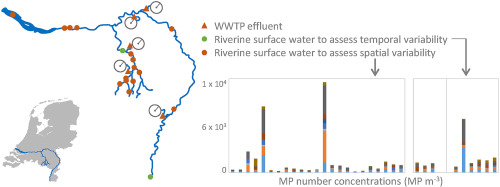当前位置:
X-MOL 学术
›
Water Res.
›
论文详情
Our official English website, www.x-mol.net, welcomes your
feedback! (Note: you will need to create a separate account there.)
A systems approach to understand microplastic occurrence and variability in Dutch riverine surface waters.
Water Research ( IF 11.4 ) Pub Date : 2020-03-16 , DOI: 10.1016/j.watres.2020.115723 S M Mintenig 1 , M Kooi 2 , M W Erich 3 , S Primpke 4 , P E Redondo-Hasselerharm 2 , S C Dekker 5 , A A Koelmans 2 , A P van Wezel 6
Water Research ( IF 11.4 ) Pub Date : 2020-03-16 , DOI: 10.1016/j.watres.2020.115723 S M Mintenig 1 , M Kooi 2 , M W Erich 3 , S Primpke 4 , P E Redondo-Hasselerharm 2 , S C Dekker 5 , A A Koelmans 2 , A P van Wezel 6
Affiliation

|
Assessment methods on data quality and environmental variability are lacking for microplastics (MP). Here we assess occurrence and variability of MP number concentrations in two Dutch rivers. Strict QA/QC procedures were applied to identify MP using Fourier-transform infrared (FTIR) microscopy followed by state of the art automated image analysis. For a series of randomly selected, yet ever smaller subareas of filters, we assessed how accurately MP numbers and polymer types are represented during partial filter analysis. Levels of uncertainty were acceptable when analysing 50% of a filter during chemical mapping, and when identifying at least a subset of 50 individual particles with attenuated total reflection (ATR)-FTIR. Applying these guidelines, MP number concentrations between 67 and 11532 MP m-3 were detected in Dutch riverine surface waters. Spatial differences caused MP number concentrations to vary by two orders of magnitude. Temporal differences were lower and induced a maximum variation of one order of magnitude. In total, 26 polymer types were identified, the most common were polyethylene (23%), polypropylene (19.7%) and ethylene propylene diene monomer rubber (18.3%). The highest diversity of polymer types was found for small MPs, whereas MP larger than 1 mm was scarce and almost exclusively made of polyethylene or polypropylene. Virtually all sampling locations revealed MP number concentrations that are considerably below known effect thresholds for anticipated adverse ecological effects.
中文翻译:

一种系统的方法来了解荷兰河滨地表水中微塑性的发生和变化。
微塑料(MP)缺乏数据质量和环境变异性的评估方法。在这里,我们评估了两条荷兰河流中MP含量浓度的发生和变化。应用严格的QA / QC程序,使用傅里叶变换红外(FTIR)显微镜进行MP识别,然后进行最先进的自动图像分析。对于一系列随机选择但越来越小的过滤器子区域,我们评估了在部分过滤器分析过程中MP数量和聚合物类型的精确度。在化学制图过程中分析50%的滤光片,以及在至少50个具有衰减的全反射(ATR)-FTIR的单个粒子的子集中,可以确定不确定度。根据这些指导原则,在荷兰河水地表水中检测到MP数浓度在67和11532 MP m-3之间。空间差异导致MP数浓度变化两个数量级。时间差异较低,并引起一个数量级的最大变化。总共确定了26种聚合物类型,最常见的是聚乙烯(23%),聚丙烯(19.7%)和乙丙二烯单体橡胶(18.3%)。对于小型MP,发现聚合物类型的多样性最高,而大于1 mm的MP则很稀少,并且几乎完全由聚乙烯或聚丙烯制成。几乎所有采样地点都显示出MP数浓度大大低于预期的不利生态影响的已知影响阈值。确定了26种聚合物类型,最常见的是聚乙烯(23%),聚丙烯(19.7%)和乙丙二烯单体橡胶(18.3%)。对于小型MP,发现聚合物类型的多样性最高,而大于1 mm的MP则很少,并且几乎完全由聚乙烯或聚丙烯制成。几乎所有采样地点都显示出MP数浓度大大低于预期的不利生态影响的已知影响阈值。确定了26种聚合物类型,最常见的是聚乙烯(23%),聚丙烯(19.7%)和乙丙二烯单体橡胶(18.3%)。对于小型MP,发现聚合物类型的多样性最高,而大于1 mm的MP则很少,并且几乎完全由聚乙烯或聚丙烯制成。几乎所有采样地点都显示出MP数浓度大大低于预期的不利生态影响的已知影响阈值。
更新日期:2020-03-16
中文翻译:

一种系统的方法来了解荷兰河滨地表水中微塑性的发生和变化。
微塑料(MP)缺乏数据质量和环境变异性的评估方法。在这里,我们评估了两条荷兰河流中MP含量浓度的发生和变化。应用严格的QA / QC程序,使用傅里叶变换红外(FTIR)显微镜进行MP识别,然后进行最先进的自动图像分析。对于一系列随机选择但越来越小的过滤器子区域,我们评估了在部分过滤器分析过程中MP数量和聚合物类型的精确度。在化学制图过程中分析50%的滤光片,以及在至少50个具有衰减的全反射(ATR)-FTIR的单个粒子的子集中,可以确定不确定度。根据这些指导原则,在荷兰河水地表水中检测到MP数浓度在67和11532 MP m-3之间。空间差异导致MP数浓度变化两个数量级。时间差异较低,并引起一个数量级的最大变化。总共确定了26种聚合物类型,最常见的是聚乙烯(23%),聚丙烯(19.7%)和乙丙二烯单体橡胶(18.3%)。对于小型MP,发现聚合物类型的多样性最高,而大于1 mm的MP则很稀少,并且几乎完全由聚乙烯或聚丙烯制成。几乎所有采样地点都显示出MP数浓度大大低于预期的不利生态影响的已知影响阈值。确定了26种聚合物类型,最常见的是聚乙烯(23%),聚丙烯(19.7%)和乙丙二烯单体橡胶(18.3%)。对于小型MP,发现聚合物类型的多样性最高,而大于1 mm的MP则很少,并且几乎完全由聚乙烯或聚丙烯制成。几乎所有采样地点都显示出MP数浓度大大低于预期的不利生态影响的已知影响阈值。确定了26种聚合物类型,最常见的是聚乙烯(23%),聚丙烯(19.7%)和乙丙二烯单体橡胶(18.3%)。对于小型MP,发现聚合物类型的多样性最高,而大于1 mm的MP则很少,并且几乎完全由聚乙烯或聚丙烯制成。几乎所有采样地点都显示出MP数浓度大大低于预期的不利生态影响的已知影响阈值。










































 京公网安备 11010802027423号
京公网安备 11010802027423号